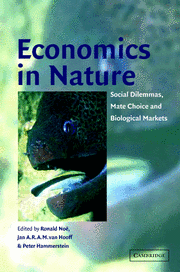Book contents
- Frontmatter
- Contents
- List of contributors
- Preface
- Acknowledgments
- 1 Games and markets: economic behaviour in humans and other animals
- Part I Economic behaviour in social networks
- Part II Biological markets
- 5 Biological markets: partner choice as the driving force behind the evolution of mutualisms
- 6 The utility of grooming in baboon troops
- 7 The cleaner fish market
- 8 Modelling interspecific mutualisms as biological markets
- Part III Mating markets
- Index
5 - Biological markets: partner choice as the driving force behind the evolution of mutualisms
Published online by Cambridge University Press: 04 August 2010
- Frontmatter
- Contents
- List of contributors
- Preface
- Acknowledgments
- 1 Games and markets: economic behaviour in humans and other animals
- Part I Economic behaviour in social networks
- Part II Biological markets
- 5 Biological markets: partner choice as the driving force behind the evolution of mutualisms
- 6 The utility of grooming in baboon troops
- 7 The cleaner fish market
- 8 Modelling interspecific mutualisms as biological markets
- Part III Mating markets
- Index
Summary
Choice as a selective force
Selection, the driving force of evolution, is the process by which varieties that are better adapted to their environment increase in frequency relative to less well-adapted forms over the generations. The ‘environment’ is often perceived as a relatively passive mould into which the organism fits more or less well. Often enough, however, organisms literally select among other organisms and by their choice alter the relative fitness of the individuals among which they choose. Cheetahs, for example, may select the weakest individual in a group of Thomson gazelles (Caro 1986) and peahens may prefer peacocks with large, elaborate trains (Petrie et al. 1991).
Systems such as the peacock's mating system, in which the members of one class of organisms benefit from being chosen by members of another class, have properties similar to human markets on which goods or services are exchanged. These properties are:
• Commodities are exchanged between individuals that differ in the degree of control over these commodities.
• Trading partners are chosen from a number of potential partners. On average the interaction with a chosen partner yields a higher ‘profit’ than an interaction with a random partner, i.e. a fitness gain in evolutionary terms.
• There is competition among the members of the chosen class to be the most attractive partner. This competition by ‘outbidding’ causes an increase in the value of the commodity offered and hence its production costs. In evolutionary terms: stronger competition forces organisms to accept less favourable fitness effects from interactions.
• Supply and demand determine the bartering value of commodities exchanged.
• Commodities on offer can be advertised. As in commercial advertisements there is a potential for false information.
- Type
- Chapter
- Information
- Economics in NatureSocial Dilemmas, Mate Choice and Biological Markets, pp. 93 - 118Publisher: Cambridge University PressPrint publication year: 2001
- 61
- Cited by



